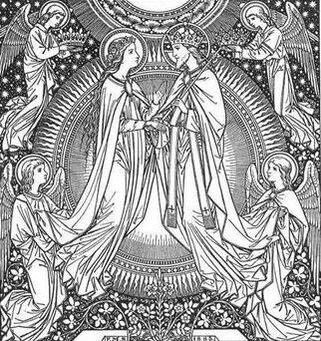
Now we will speak of the Assumption of Our Lady into heaven, which is kept, as you know, on the 15th of August, and is a Holy Day of Obligation that is, it is one of those days which the Church commands us to keep holy as we keep the Sundays, by hearing Mass and doing no unnecessary servile work.
You know that the Gospels tell us very little about Our Lady during the public life of her Divine Son, and nothing at all of what she did or where she lived after His ascension into heaven. Even St. Luke, who loved to write about the holy Child and His Mother, and who also wrote the Acts of the Apostles, tells us nothing at all of what we should so much like to know. We can only suppose that the Queen in her humility desired both St. John and St. Luke to be silent as to all that concerned her. She knew that "henceforth all generations should call her blessed," because "He that is mighty had done great things to her," and that was enough.
But the Apostles and the early Christians treasured many memories of what happened to their Mother and ours; and these memories were handed down in the Church by tradition, even if they were not found in the written word of God. We know that Out Lord when dying left His Blessed Mother to the care of St. John and "That disciple took her to his own."
We learn from tradition that Mary went with her adopted son to Ephesus, and that after spending some years there she returned to Jerusalem in order to visit again the scenes of Our Lord's Passion and death before she herself went to rejoin Him in heaven.
About twelve years after He had ascended from the top of Mt. Olivet her call came, and Mary gave her soul into the hands of God. Her body was buried by the Apostles, but it was not allowed to remain in the tomb. As Our Lord had preserved her soul from the taint of Original Sin, so He preserved her most pure body from the corruption which is a part of sin's punishment. On the third day Mary's soul and body were reunited by the power of God, and borne by angels triumphantly to heaven. This is what is meant by the Assumption.
"Then it is just the same as the Ascension?"
No; it is not at all the same. To ascend is to go up by your own will and your own power; to take yourself up, in fact. To be assumed is to be taken up by the will and power of another. Our Lord ascended went up entirely by His own power; the Queen was assumed or carried up by the will and power of God.
Two other persons have been assumed into heaven by the power of God: Enoch and Elias. But they were not taken into the beatific vision, and they must return to earth some day to die. The Blessed Mother's body, on the other hand, was reunited to her soul and passed into the presence of God, where she will be happy for all eternity.
If you look at a picture or a stained-glass window of the Assumption, you will probably see the Apostles represented as kneeling or standing around an open tomb which is filled with flowers - generally roses and lilies. The story is this:
When the Queen was about to die, the Apostles, who had known and loved her, were scattered abroad, "teaching all nations and baptizing them," but they learned by revelation that Mary was leaving the earth, and they were carried by the power of God to Jerusalem that they might see her once more and say farewell. Only poor Thomas did not reach the Holy City until after the burial of the Queen. He was so sorry, and the others were sorry for him, that they determined to open the sepulcher so that Thomas might look upon the beautiful face once more. But he was really too late this time. "The stone was rolled back from the sepulcher," and they found nothing within but lilies and roses. The body of the Blessed Mother had been taken to heaven.
The Assumption of Our Lady has never been declared and Article of Faith, but has always been believed by the faithful. The Church has testified her approval of the belief by establishing a festival in honor of this great privilege of Mary, and by making this festival a Holy Day of Obligation. It is a Double with an Octave and has its own most beautiful Mass.
The priest wears white vestments on the feast of the Assumption, as on all the festivals of the Queen. Its eve or Vigil is a fasting day.
The feast of the Assumption has been kept from very early days, but before the invention of printing and telegraphy and such aids to quick learning, knowledge spread slowly. In the fifth century after Our Lord, the Empress Pulcheria, who was learned lady and a saint besides, sent to the Patriarch of Jerusalem for relics of the Queen, wherewith to enrich a church built in her honor. What the good Patriarch told Pulcheria about the Assumption was the first she had heart of it. However, she took care to let the other people know, and very soon the festival of the Assumption was kept throughout the Church.
If ever you go to the Holy Land, you may visit the empty tomb of the Blessed Mother in the Garden of Gethsemane.
Source: The Queen's Festivals, Imprimatur 1907


 RSS Feed
RSS Feed